Intel Core i9 Review - dresslerhampon
Intel. Strikes. Back. The big 18-core Marrow i9-7980X and 16-core Core i8-7960X are the chipmaker's response to AMD's Ryzen Threadripper, which has been eating Intel's lunch for umpteen months.
Simply can Goliath Intel rise from its stunning defeat to challenge David AMD to a re-match? Can information technology dro rumors of clock speeds and high temperatures? To find out you'll give to read on.
Because thither's thus more than to say about Core i9, we frame the prices, features and FAQs into a separate story you'll want to read for setting. For this review, we'll walk through some of the under-the-hood issues directly related to operation, and then we'll dive into the benchmarks.
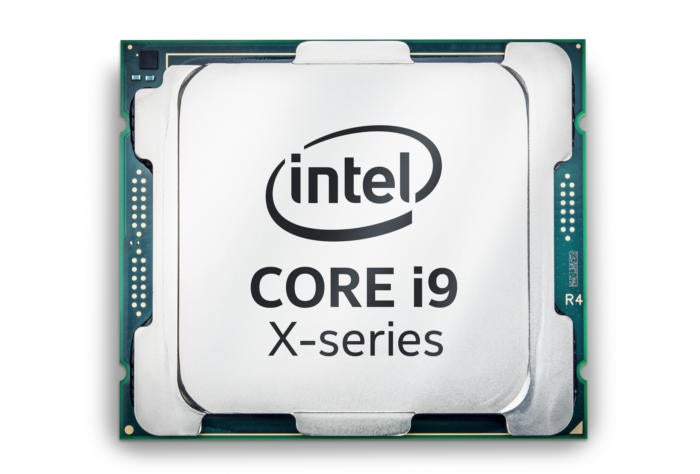 Intel
Intel Core i9, under the hoodlum
Core i9 is the first new "Core i" Intel has introduced in 10 years. The company guarded the secret so intimately that IT regular by desig mislabeled the first round of chips (including our survey taste) as "Core i7" to throw off leakers. Our 16- and 18-core samples are labeled correctly, however.
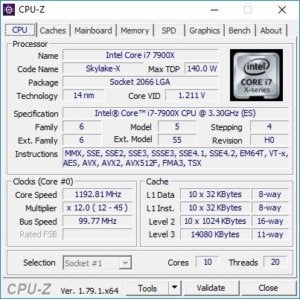 IDG
IDG CPU-Z thinks the Meat i9 is a Core i7.
Like most major Intel launches, the Core i9 family represents a refreshing platform, not scarce a new CPU, which means a new chipset, the X299, and a new socket, the LGA2066, every last incompatible with previous CPUs.
The new platform also does something atomic number 102 previous one did by unifying two Central processor families. Before today, if you wanted the keep company's latest Kaby Lake core, you had to buy out a motherboard exploitation the LGA1151 socket. And if you wanted to buy, say, a 6-burden Skylake CPU such as Intel's Core i7-6800K, you had to grease one's palms an LGA2011 V3-settled motherboard.
With X299 and LGA2066, you toilet now piece your poison, because the platform encompasses everything from a 4-core Core i5 Kaby Lake CPU to an 18-core Core i9 Extreme Edition, which is a Skylake CPU. For clarity's saki, the Kaby Lake CPUs, also called Kaby Lake-X, are the Heart i5-7640X and the Kernel i7-7740X. The rest of the Nub i7 and Core i9 CPUs are Skylake, collectively called Skylake-X.
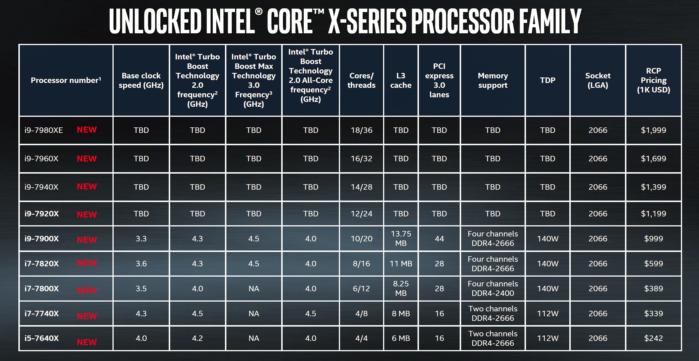 Intel
Intel The Kernel X serial is made prepared of CPUs constructed with Skylake-X cores and Kaby Lake-X cores. The teras 18-core part is expected in October.
This union has been greeted with roughly confusion and trepidation. It's promising that X299 motherboards will be pricey. Some are rightly speculative who would buy a $350 motherboard to install a $250 CPU.
[ Further reading: Every Intel X299 motherboard revealed: Core i9 and Skylake-X's companions ]
Intel's motives for the Kaby Lake-X may actually be a nod to the overclocking sports. Unlike LGA1151-socketed Kaby Lake chips, Kaby Lake-X chips get no integrated artwork capacity. As a matter of fact, we've been told the chips physically have no IGP on the die at all. This allows the cardinal Kaby Lake-X chips to overclock potentially far higher than the LGA1151 versions. At the recent Computex evince in Taipei, in fact, Intel said a record was Set for the highest overclock of a Kaby Lake chip, and it was connected X299.
In a perfect world, we'd every last have 18-core CPUs, but the truth is there are those who buy cheesy CPUs on polite motherboards. Kaby Lake-X is for you.
PCIe lanes: Unmoving being rationed
Still, having Kaby Lake-X and Skylake-X on the same socket is bound to create confusion. Exhibit A is the PCIe rationing. With the Marrow i9-7900X, e.g., you get quad-channel retention keep going and 44 PCIe Gen 3 lanes at once from the CPU. If you were to drop a Core i7-7740K into the same ramp up, the motherboard drops down to dual-channel memory support. Maybe worse, the PCIe lanes drop to 16, because that's the supreme supported by the Kaby Lake core. That means some of the slots happening a motherboard would fall noncurrent in operation or be completely disabled.
Piece Kaby Lake-X's 16-lane limit is owing to the CPU's design, Intel dials back PCIe lanes on Skylake-X intentionally. Rather than the 44 lanes the 10-core version gets, the 6-core and 8-core versions of Skylake-X get just 28 lanes. From what we interpret, there's no technical reason for it, just "marketplace segmentation," which is a business school way of saying, "so we can charge you more." Oy.
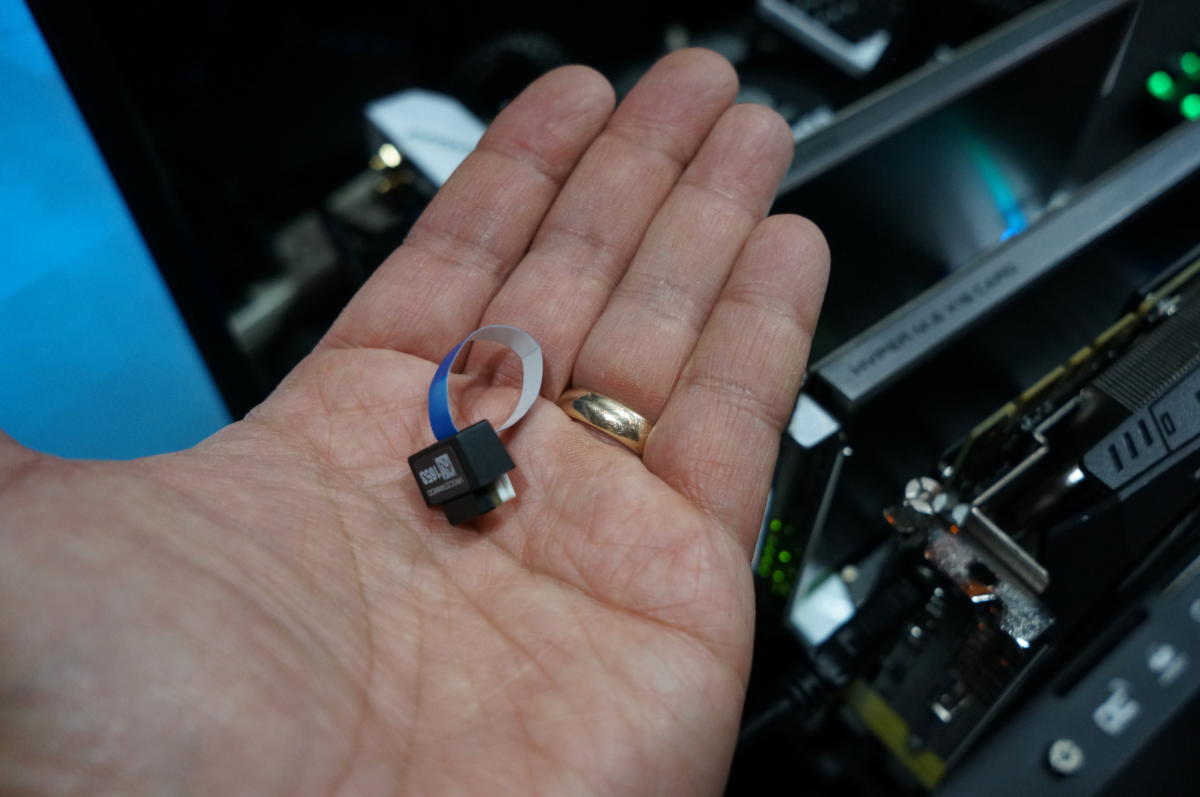 IDG/Gordon Mah Ung
IDG/Gordon Mah Ung You may have to purchase a special dongle tonality the likes of this if you neediness to use X299's VROC feature enabling RAID up to 20 NVMe drives.
Intel VROC
Even more controversial than PCIe rationing is Intel's VROC, or Virtual RAID on CPU. It's a nifty feature happening Skylake-X that allows a user to configure awake to 20 NVMe PCIe drives in Foray into into a single bootable segmentation.
The problem? Intel apparently intends to charge more money for the feature. Inside information haven't been released, but vendors at Computex told us they believed RAID 0 would be free, RAID 1 would toll $99, and RAID 5 and RAID 10 could toll $299. Once you've ponied up the cash, you get a computer hardware dongle that unlocks the characteristic.
It gets worsened: VROC will work only with Intel SSDs and pricier Skylake-X parts. If you corrupt Kaby Lake-X, you're shut impermissible. VROC also applies but to PCIe RAID that runs directly through the CPU's PCIe lanes. X299 still supports various RAID 0, 1, 5, 10 through the chipset, but the chipset RAID won't touch the carrying out you set out from VROC.
We'll reserve final discernment until Intel confirms pricing. Considering the face-palms it caused at Computex, we're interested to pick up how this shakes prohibited if it ever does.
 Intel
Intel AVX 512 in the Skylake-X promises ALIR more performance—just only when the code supports IT.
How Core i9 changes Skylake
Once you've gotten beyond the platform confusion and controversy, there's a reinforce. The Skylake-X chip itself is indeed something to admire, because it's reinforced unlike whatever previous high-end Intel consumer chip.
Past "enthusiast" Beaver State "intense" CPUs have largely been the same. That is, a 4-essence Haswell Core i7-4770K wasn't every last that diametric from from an 8-core Haswell-E Core i7-5960X except for the endure of quad-channel RAM.
With Skylake-X, Intel breaks from tradition, with more or less major tinkering under the punk. The most noticeable is an increase in Mid-Flush Cache (MLC), or L2 squirrel away: Intel has quadrupled it to 1MB per core, up from 256MB in last year's Broadwell-E and the majority of Intel's CPUs. The Last-Level Cache (L3) actually gets smaller, with 1.375MB per core versus the 2.5MB of the preceding Broadwell-E chip, but Intel compensates with the larger MLC and also the use up of a non-comprehensive cache purpose. Compared to the comprehensive design in Broadwell-E, which might keep data that's not needed, non-inclusive cache attempts to track what should be in the cache so it can more efficiently use the available space.
 Intel
Intel Skylake is very different from Sklyake-X, and much of that has to do with the cache, AVX512, and a new mesh interface.
Intel also ditches the call bus architecture IT has used for some years (including Kaby Lake and Skylake) for a unused mesh architecture. If you reckon of a quad-core CPU as cardinal homes connected by a bus line that makes stops at apiece home, it's absolutely fine until you tot, say, 12 or 18 homes to the biotic community. You could link two coach lines, but that still isn't equally fast as just impulsive from one home to the next, which is what the refreshing mesh topology computer architecture does.
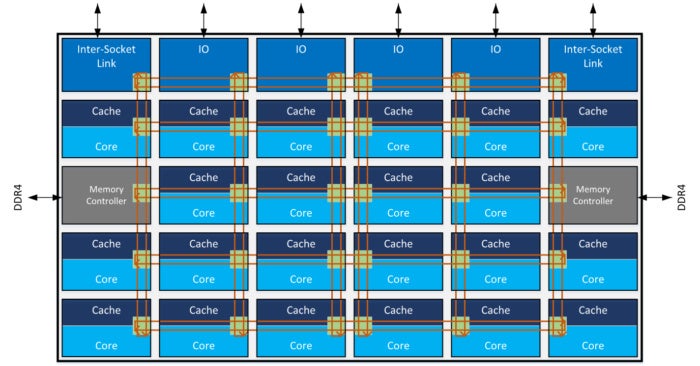 Intel
Intel The ring bus computer architecture of recent CPUs gets dumped for a mesh computer architecture that can scale raised far more cores.
Intel's use of a meshing designing clearly puts it on a better footing to contend with Threadripper, as more and more cores are added to CPUs. AMD's Ryzen series uses something it calls an Infinity Fabric, which is basically a ace-high-velocity engage network.
The last feature worth noting is the cleared Turbo Encouragement Max 3.0. This is the feature wherein Intel identifies the "best" C.P.U. center at the factory and gives information technology a lowercase more hike speed. With Broadwell-E CPUs, only one meat was chosen. With Skylake-X, two cores are identified as the "topper" and allowed to run a couple of hundred megahertz quicker.
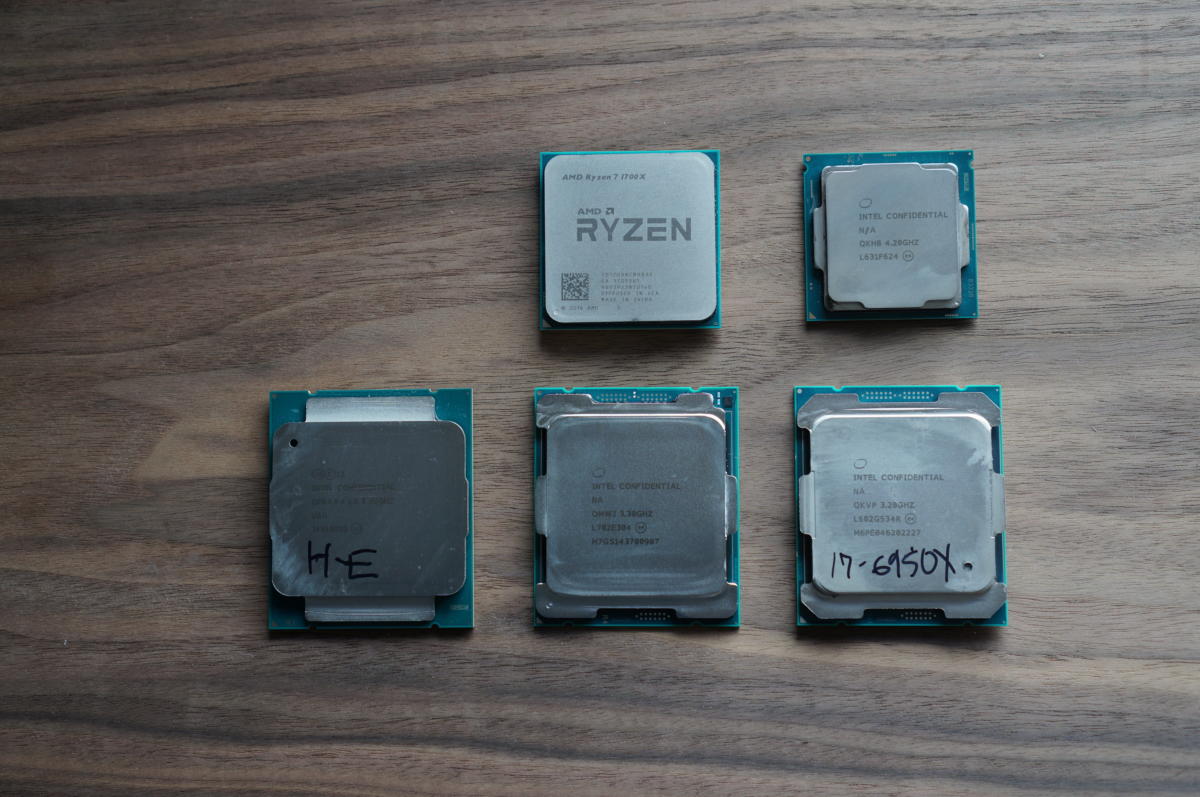 IDG/Gordon Mah Ung
IDG/Gordon Mah Ung Core Wars: Instalment IV (can you spot the blunder in this picture?
18-core Core i9 operation
For our public presentation testing, we ejected the 10-core Core i9-7900X from the socket of our Asus Select X299-Elegant and installed our 18-core Core group i9-7980X. Else than that, the components haven't changed from our original Core i9-7900X critique, including: a GeForce GTX 1080 Founders Edition, 32GB of DDR4/2600 RAM, and a HyperX 240GB Savage SATA SSDs. For our Adobe Premiere CC 2017 test, the source project and the target drive used a Plextor M8pe PCIe SSD in all but the Core i5 and the Ryzen 5 CPUs. This exception is expected to a trouble with the Ryzen 5's motherboard, which failed to recognize the Plextor parkway. A Samsung 960 Pro NVMe SSD was swapped in. The AMD Ryzen Threadripper 1950X cadaver the unvarying as when we first reviewed the chip.
Referable time constraints, some of the tests also feature film scores from a Substance i9-7960X—the 16-core version of the chip. The CPU was in use in a pair of congruent Falcon Northwest Talon systems we used for our upcoming Threadripper vs. Core group i9 face-of. Although that system features completely different GPUs, the Processor is bone stock, so the CPU-single tests are logical to compare.
Cinebench R15 operation
Our first test is CineBench R15, a discharged 3D rendering run based on Maxon's nonrecreational Cinema4D engine. It's near exclusively CPU bound and also scales selfsame well As you gain the numeral of CPU cores and threads.
The topmost frank is not a surprise: Intel's 18-sum Core i9-7980X, with the 16-core Core i9-7960X getting the silver ribbo. AMD's Threadripper 1950X, once undisputed among consumer CPUs, has to descend for the bronze.
But the placing of that Threadripper 1950X is nothing to follow ashamed of. Yes, AMD fans, yes, we know: It costs significantly less. Let's just acknowledge that now and then you nates read the rest of this revue without constantly want to scream, "merely it cost a ton inferior!" Just silently repeat that musical phrase after every test result you see.
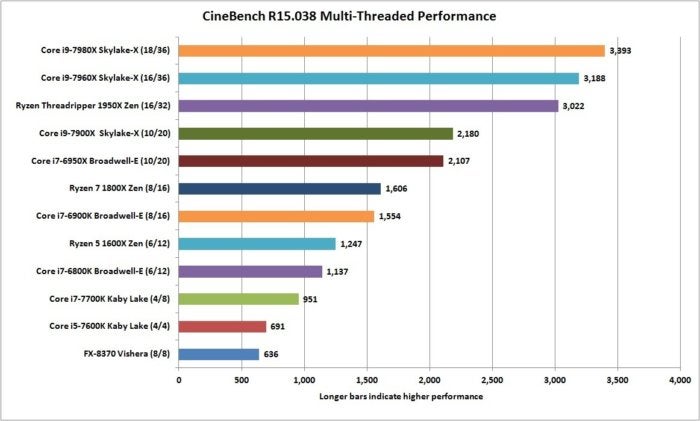 IDG
IDG Cinebench R15 gives the 18-pith Inwardness i9 the gold medal, the 16-core Core i9 a silver and Threadripper 1950X is consigned to a bronze.
Multi-threaded public presentation ISN't the end-all be all. The pensive truth is the immense majority of applications and games just don't use all of those cores, so we also use CineBench to measure single-rib performance. Surprise: The Core i9-7980X comes out on overstep, pulling ahead of even the higher clocked Core i7-7700K CPU. For the most part we really see three tiers of performance, with the Kaby Lake and Skylake-X chips on top, and then Broadwell and Zen-based chips thereunder.
To restrain this all in position, we're really not looking at a large difference between a Skylake-X chip and a Broadwell-E or Zen chip. But the success is clearly Core i9 and Skylake-X.
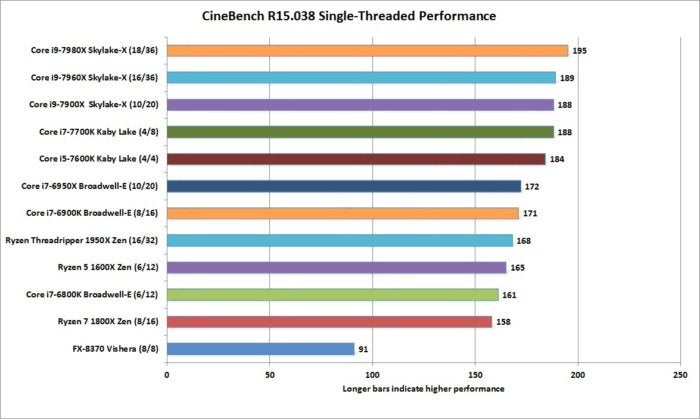 iDG
iDG Single-threaded public presentation in Cinebench R15 is valuable for gauging how a CPU will perform in the vast legal age of applications and games.
POV Ray performance
The Persistence of Vision Raytracer actually traces its lineage back to the day of the Commodore Amiga, and it continues to be supported by an brisk community of developers. Like Cinebench, it favors high burden- and wander-numeration chips. The results are predictable, with 18-core Core i9-7980X happening top. That 16-core Ryzen Threadripper 1950X does pretty well, but two more cores pay real dividends.
 IDG
IDG POV Ray's internal benchmark says Thomas More cores equals moar carrying into action and 18 > 16.
As we still want to know how CPUs get along under much barge loads, we besides run POV Ray using a single train of thought. The results again party favor high-clock-speed quad-cores, but the Skylake-X chips string up close, and the Zen and Broadwell-E chips aren't that far behind. The just give chase here is AMD's ancient Vishera-based FX CPU.
 IDG
IDG POV Ray 3.7 puts the highest clocked and highest IPC chips on the top of the mickle.
Blender carrying out
Our next psychometric test is the open-source Liquidiser modeler. It's a popular app accustomed make up personal effects for many indie movies. Blender performance results can vary greatly by the workload. E.g., sample benchmarks provided for Intel's quad-substance Kaby Lake and AMD's Ryzen preceptor't actually plate with inwardness number. For this prove, we run the popular Microphone Pan BMW benchmark. The winners again are Intel's two fashionable Core i9 CPUs, with the Threadripper 1950X coming in somewhat behind them.
IT's a good showing for all trey but, again, Liquidiser's performance very much depends connected what model and what you're doing. We've as wel found Liquidizer to be very sensitive to the operating arrangement.
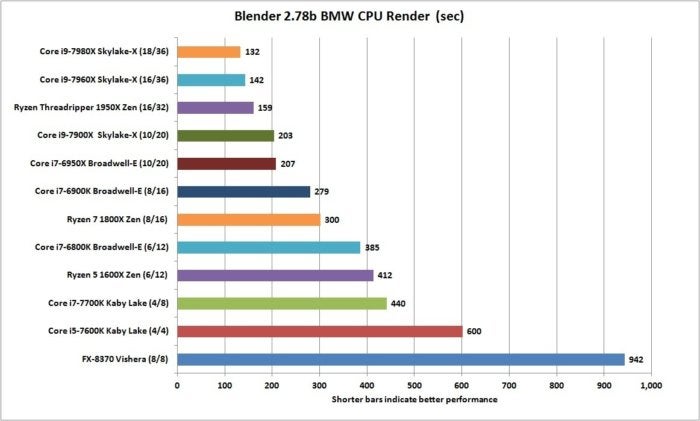 IDG
IDG The ASCII text file Blender renderer favors CPUs with more cores too. We use Mike Pan's popular BMW try bench mark file.
Because these are the big-nerd chips, we decided to throw something heavier at them in the form of the Gooseberry bench mark file. It's a benchmark skeletal system from the Liquidiser Institute's upcoming open-generator movie: Cosmos Laundromat. While the BMW benchmark takes a couple of minutes Oregon troika to run, Gooseberry pushes it to to a higher degree 20 minutes to interpret a frame.
The results in Ribes uva-crispa look great for the new Core i9s and definitely rouge a worsened picture for the 16-core Threadripper 1950X in our Falcon Northwest Talon PC. Even worsened, a screen on our reference automobile was a little slower, too.
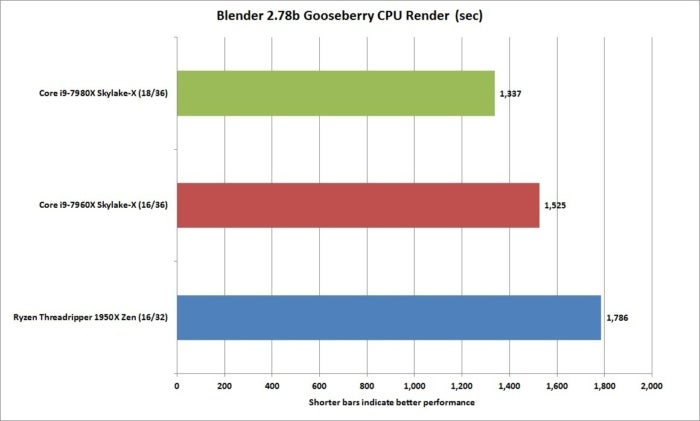 IDG
IDG Gooseberry puts Intel's new Core i9 chips easily ahead of the AMD Threadripper 1950X.
WinRAR performance
We experience from our original Core i9-7900X and our Threadripper 1950X review that WinRAR just doesn't seem to like the ensnarl-like architectures of the Threadripper and Effect i9 chip. No storm that we'rhenium seeing the same thing here, but IT is astonishing that Intel's older Broadwell-E chips orevail. Threadripper just does selfsame poorly here.
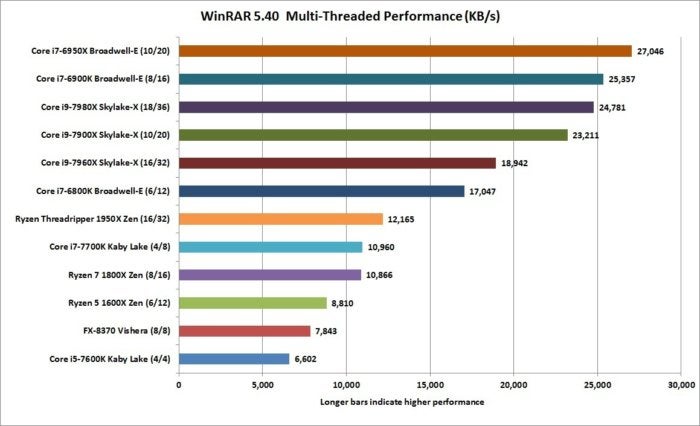 IDG
IDG RARLab's WinRAR doesn't particulary like the new mesh architecture in Skylake-X but it really seems to hate AMD's Zen architecture.
7-Zip performance
We use the 9.20 version of the unconfined 7-Speed up and run the inherent multi-rib test. The clear winners by a larger-than-expected margin are the new Core i9's.
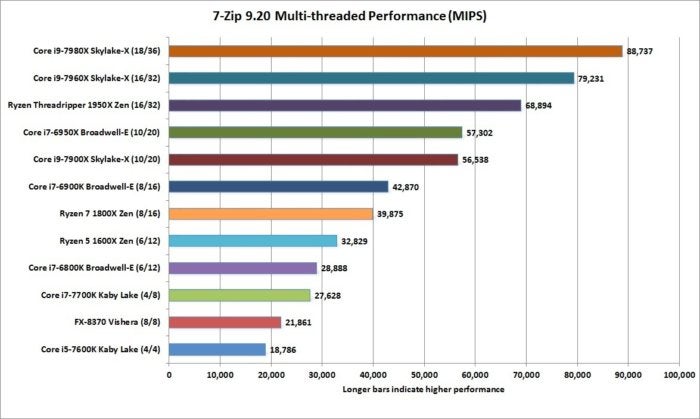 IDG
IDG The free and popular 7 Zip puts the chips the most cores at the front of the line.
Corona Renderer performance
If you flavour at Cinebench, Liquidizer and POV, the public presentation spreads between the 16-core Threadripper and brand-new Core i9 is there, though small. In Corona Renderer, we're seeing performance gaps that might inflame you up. The 16-core Core i9-7960X enjoys a 25-percent performance gap over the equivalent 16-core Threadripper 1950X. It's even worsened with the 18-Congress of Racial Equality Core i9-7980X.
Before you scream the bench mark is sunny-side up in favour of of Intel's micro-computer architecture, this particular benchmark was something introduced to most of U.S.A by AMD for the original Threadripper review. Frankly, this just isn't jolly.
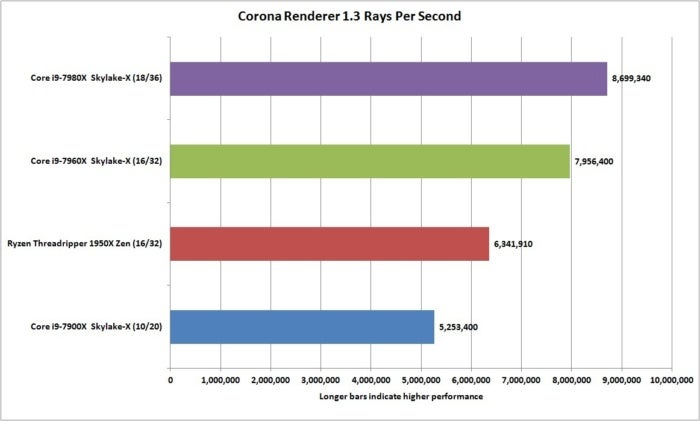 IDG
IDG The Corona Render shows the 16-core Threadripper acquiring hammered by the 16- and 18-CORE Core i9 chips.
Handbrake functioning
Not everyone does 3D modelling for a living, but an tremendous lot edit or change over videos, and that's where having Sir Thomas More cores generally benefits you. To look at encryption public presentation of the new Core i9, we used the popular and free Handbrake encoder to convert a 30GB 1080p picture using the built-in Android tablet preset.
Ane upsho we've seen with the version of Handbrake and the workload we use is the diminishing returns on the big-core CPUs. You can see the we pick up performance as we go from quad-cores to 10 cores, but once we'Ra on the far side 10 cores, we're not picking up the performance dividends you'd expect at 16 operating theatre 18 cores.
Still, both Core i9s are in front, with Threadripper likewise giving leading very respectable carrying out here.
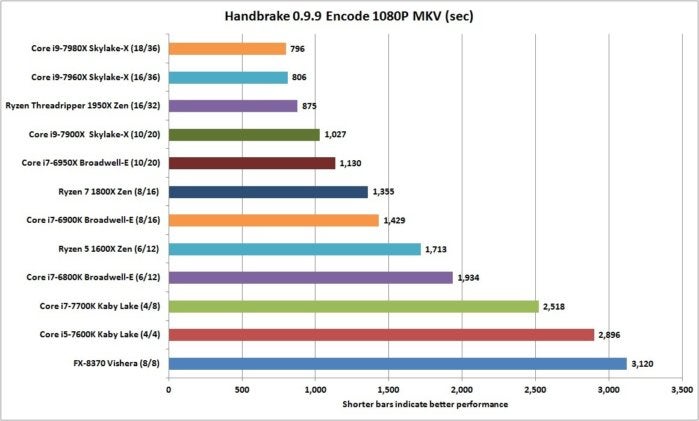 IDG
IDG Our workload for the free Handbrake encoder favors more cores besides but it doesn't pay the same performance dividends the way a professional 3D renderer would.
Premier Originative Mist Performance
The unusual half of telecasting encryption is patently in video editing. For this particular test we use Adobe brick Premier Creative Dapple 2017 and export an actual visualize shot past our video section, so information technology's as real-world as you can get. The footage was injection on a Sony Alpha camera at 4K resolution so exported using the Blu-ray preset at 1080p resolution. We likewise enable the maximum render character option, which helps improve image quality when changing the resolution. The workload is rendered on the Mainframe, which some video snobs say shut up renders the highest-quality telecasting.
Although this is same much a CPU-intensive task, we cause try to take the storage subsystem unconscious of the equating so for almost the original Ryzen 5 and Essence i5 systems we used Plextor PCIe NVMe SSD as the source and object drive. Wish Handbrake, we're not seeing stellar grading with core count, but the 18-core Core i9 rules them altogether.
Still, if you'atomic number 75 buying a big CPU every bit a video editor, you consume to view whether it's Worth it.
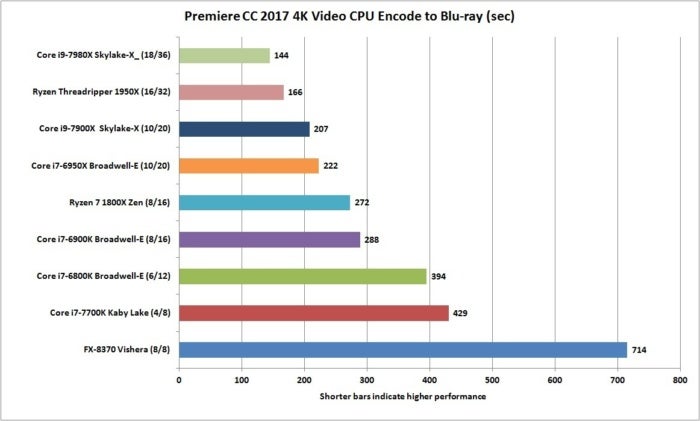 IDG
IDG Telecasting snobs say Mainframe-settled rendering is A-one and if you do that—you'll want more cores.
One thing we also want to add: A great deal of people say CPUs are irrelevant in the age of GPU-based encoding. To prove it either direction, we switched Adobe brick Premiere from C.P.U. rendering to CUDA rendering happening the GeForce GTX 1080 card. As you can see, you pick up a huge reward away using the GPU to encode, only information technology's clear that having more cores still yields dividends. The upshot is not to suppose a dual-core CPU will be better than a 10-gist CPU for television editing.
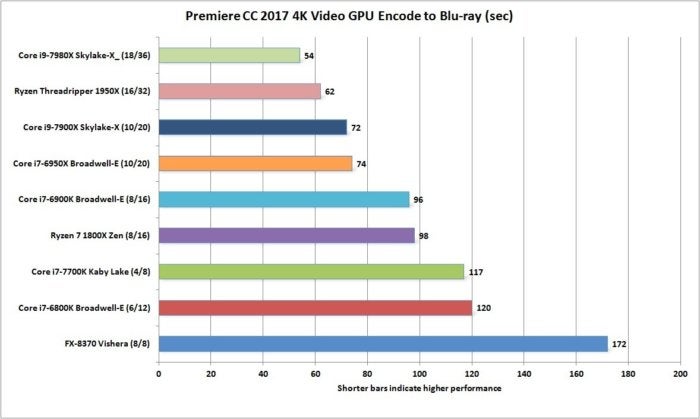 IDG
IDG Even if you use your GPU for encoding, having a CPU with more cores will still bring dow your render times.
Procession of Tomb Raider performance
Stop: If you're buying a 16- or 18-core CPU to chiefly take on games, you're doing it wrong. Your cash in hand would be more wisely played out on a faster graphics menu. But if you do play games, and you also model 3D, you want to know which Processor gives you the best performance. The answer, as we mistrust you make love, is Core i9.
We say this because we already know both the 10-CORE Core group i7-6950X and 10-core Core i9-7900X ingest an advantage in games. The newest Core i9's Don't change that pattern.
First up is Rise of the Grave Plunderer, which has been patched to address some inefficiency on the Ryzen and Threadripper platforms. We feed the game at 1920×1080 resolution and the Medium setting in DirectX 11 style.
Ahead of the pack is the 18-core Core i9-7980X, but for most part, it's pretty familiar to the 10-core Core i9-7900X. Threadripper does decently well erst kicked into its Game Mood, but the advantage goes to Core i9.
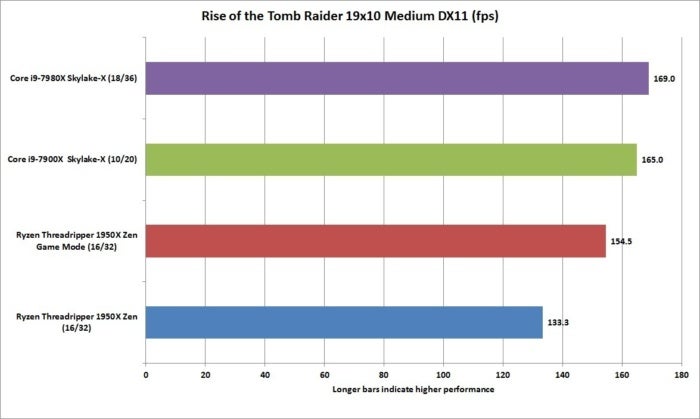 IDG
IDG Intel's Skylake-X continues to show better performance in nearly games but Threadripper 1950X is inactive very a good deal in the ball spunky.
Tom Clancy's Rainbow Six Siege carrying into action
We actually ran quite a few games on the CPUs, but for the most part the 18-nub Nub i9-7980X either led the fashio or was unreal the front of the pack. We sawing machine the same trend in Tom Clancy's Rainbow Six Military blockade when run at 1920×1080 resolution and Spiritualist settings. We do this to remove the video recording card from being the chokepoint in performance examination.
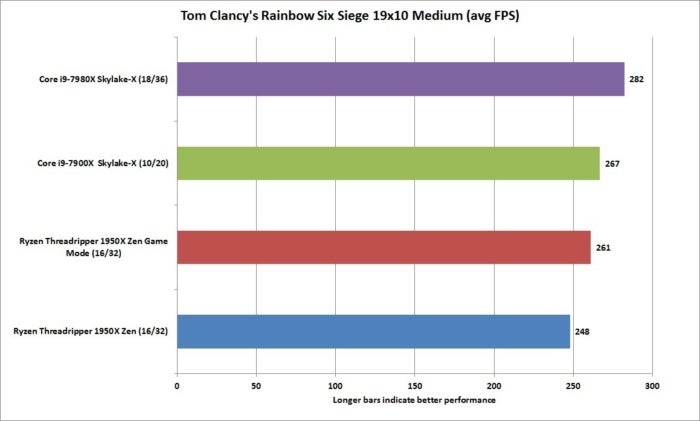 IDG
IDG Nucleus i9 takes top honors in Rainbow Sixer
3DMark Sentence Spot 1.0 operation
Our unlikely gaming test is 3DMark's Clock Spy 1.0 test. The score is sole the CPU portion, because that's each we care all but here. Once again, the Core i9-7980X is blown-up and in charge.
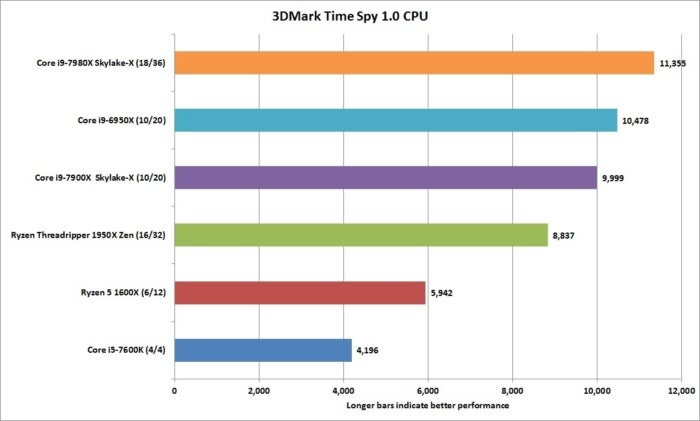 IDG
IDG 3DMark's TimeSpy puts the 18-core on top—but it's clear the engine doesn't scale with the core count much.
Power Consumption and clock speeds
One thing that's number with Sum i9-7900X is its power phthisis, and how much more power it uses than AMD. That's typically not an easy thing to test without identical hardware, but as we noted earlier, boutique Personal computer builder Falcon Nor'-west transmitted us two nearly identical, heavily loaded Talon PCs. Both feature 128GB of DDR4/2400 RAM, Samsung 960 In favour of drives, Titan Xp's in SLI, and matching power supplies, coolers, and cases. The only differences between them were the 16-core CPUs and motherboards.
This setup let us run the same CPU loads while measuring the power consumed at the socket. Because most workloads wear't in reality use all cores, we also distinct to take power consumption while ramping up 1 to 32 threads. The results confirm what everyone knew: Core i9 uses more world power.
 IDG
IDG Using a pair of nearly identical 16-core systems, AMD's Threadripper 1950X proves to glucinium more power-efficient than Intel's 16-effect Core i9-7960X.
These power measurements aren't exact, but they're close sufficient to give us an idea. It's stimulating that the Threadripper 1950X seems to level off in power consumption at about 20 togs, spell the Core i9 continues to climb.
Threadripper unquestionably has the advantage in power consumption, but that's non enough of an edge. If you genuinely care close to your multi-rib performance, an extra dollop of power consumption probably International Relations and Security Network't going to interest you.
It's identical often care Threadripper's gaming functioning. Core i9 has a certain vantage, merely to be honest, IT's probably non going to matter that overmuch given that anyone buying this class of CPU buys for content-creation priorities first.
We'll close this out with the grading performance of the 18-core Core i9-7980X under varied workloads.
We did this for our Threadripper review, and we think information technology's a great room to understand what you're getting knocked out of these chips. When it was just the 10-core Core i9-7900X versus the 16-heart Threadripper 1950X, the Marrow i9 had the edge in light lots, but the AMD Central processor led in heavier loads.
With these late Core i9's that's shifted. Not only does Intel have an edge in in light loads—it now has the edge in heavy loads. If you feeling at our Cinebench R15 results below, you can see the 18-core gives up no quarter to the AMD chip.
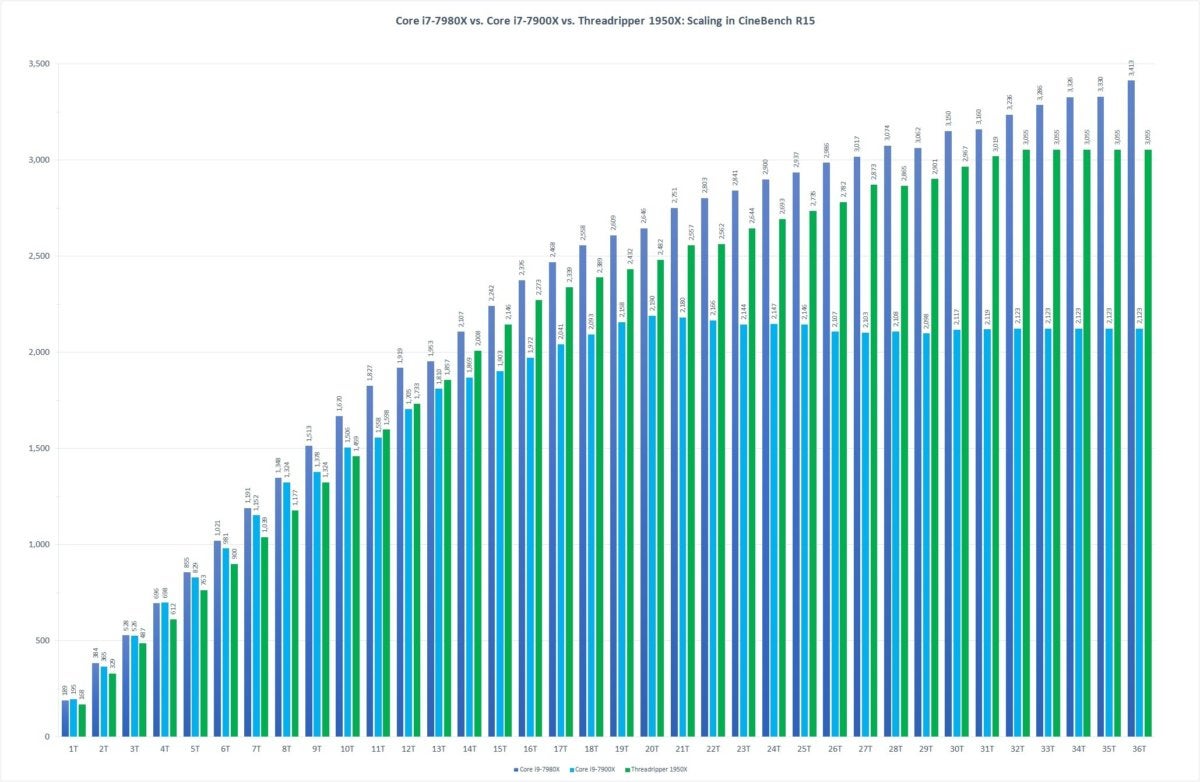 IDG
IDG Using CineBench R15, we varied workloads from one thread to 36 to show just where the performance peaks.
The price: If you have to ask round…
The star hanging over Nitty-gritty i9 and the entire Core X series is the value proposition. Of all time since our original Core i9-7900X and Threadripper 1950X reviews, we were pretty sure Intel wouldn't have any publication being the carrying into action loss leader.
The problem is being the Leontyne Price leader. Trying to peg value per performance fundament be pretty slippery, because performance is relative. We do hump that by and large Threadripper is just a bit off the pace of Core i9. So we decided to crunch the Book of Numbers on cost per string of all Core X and Threadripper chips. We also threw in the 10-core Core i7-6950X, because, asymptomatic, $1,723.
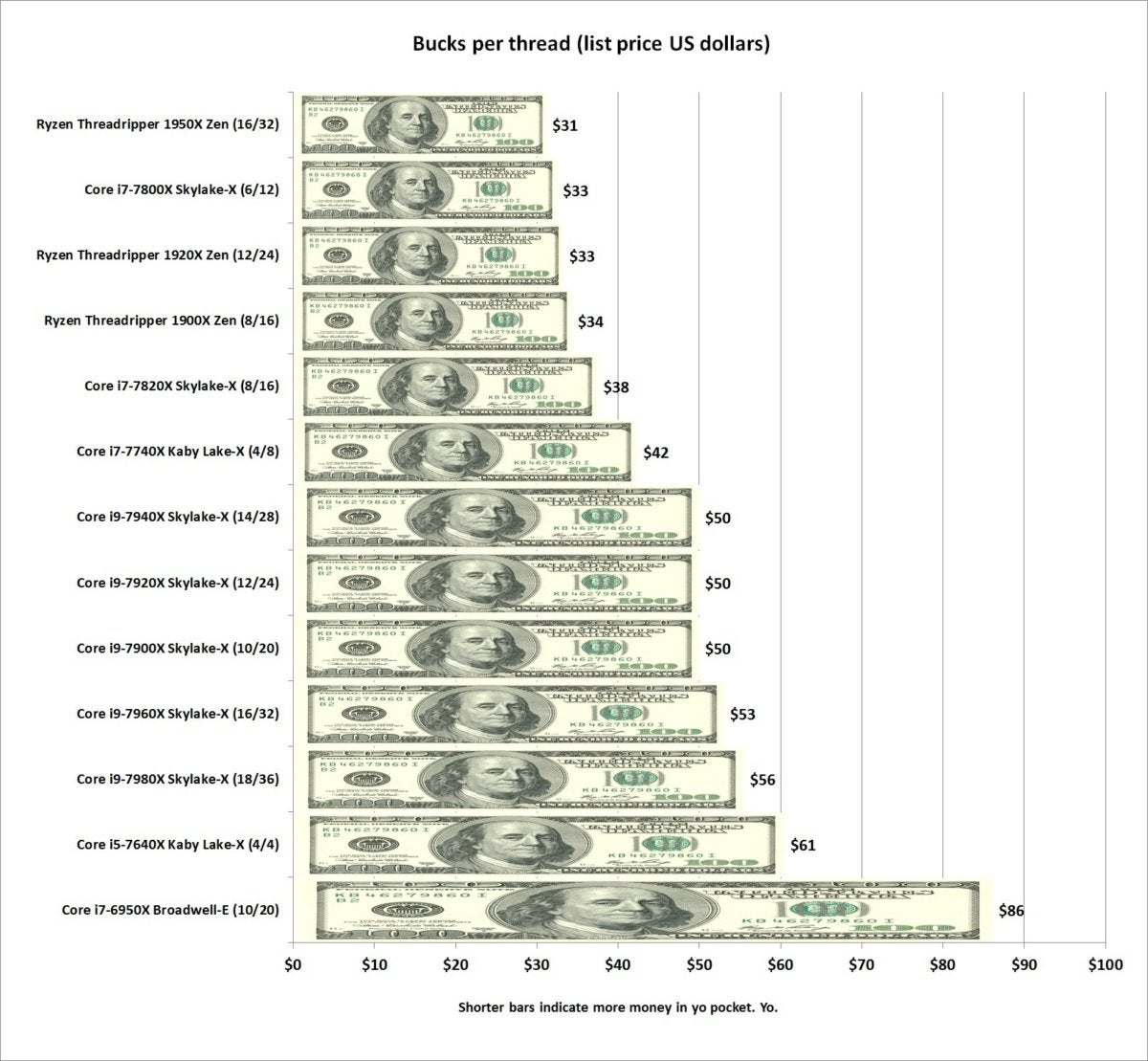 IDG
IDG Why isn't Ben Franklin grinning? He probably paid the full $1,723 for a Inwardness i7-6950X Broadwell-E, which has the highest cost per thread of the CPUs here.
Thread for thread, the worst value is that Broadwell-E chip. Unsurprisingly, Intel's Core i5-7640X comes in second-worst at $61 per thread. The real shocker here is the best value: AMD's 32-thread Threadripper 1950X.
Conclusion
There's really two ways to look at Core i9. The first is from a performance position, where on that point's no question that Intel is in charge. You'd have to look selfsame petrified and very far to find any multi-threaded benchmarks where the 16-core and 18-CORE Nub i9 lose to AMD's Threadripper. Once you move to lighter loads that favor Intel's high time speeds and advisable IPC efficiency, it only gets worse.
Soh, for performance freaks who absolutely, positively, must ingest the fastest CPUs for some ignitor duty and weighted duty, the CORE i9-7960X and Core i9-7980X are the new speed demons.
The problem, of course, is the toll differential. That last graph above should give you an idea of the economic value AMD is offering. Yes, Essence i9 may officially be faster in every way you can buoy meter, but IT can't outrun its have price.
Maybe it depends happening World Health Organization's paying. If, for example, your boss asks you to spec forbidden a new build for your video editing workstation, you'll say Intel. But if you're edifice on your own dime and nerve-racking to make the dollars stretch? The natural answer is AMD.
But make no mistake, Nub i9 is clearly the performance leader today.
Source: https://www.pcworld.com/article/407013/intel-core-i9-review-we-test-the-massive-18-core-core-i9-7980x-and-16-core-core-i9-7960x.html
Posted by: dresslerhampon.blogspot.com


0 Response to "Intel Core i9 Review - dresslerhampon"
Post a Comment